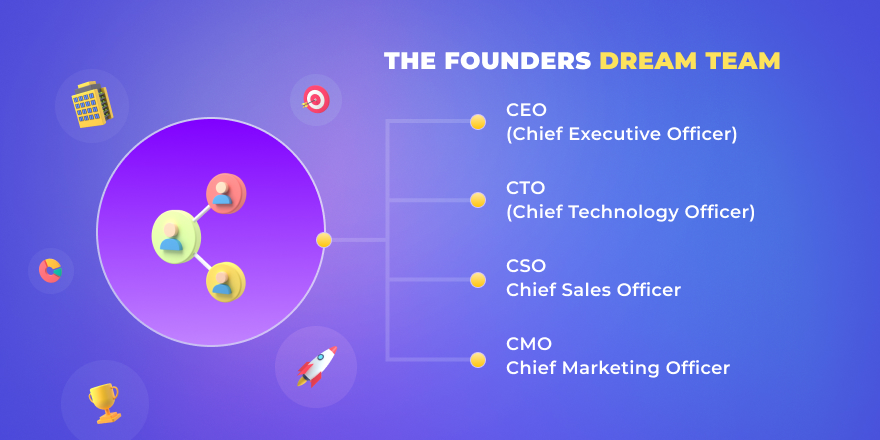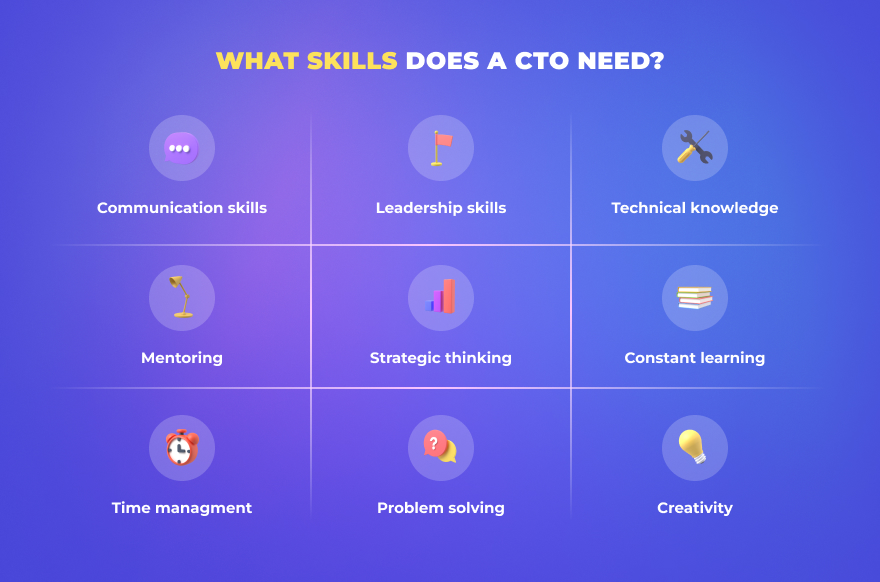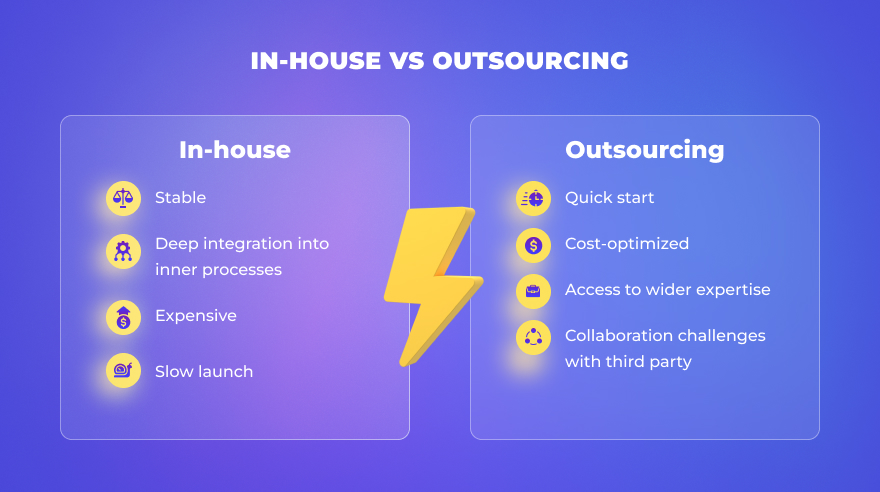Organization structure is a sore spot for the majority of startups. It might be challenging to find suitable people and set up efficient communication and cooperation between tech startup team members.
Your team structure might change pretty rapidly, especially during periods of growth and expansion. You need to find a balance between the team size, its budget, and efficiency, as well as provide decent conditions and compensations for your employees.
In this article, we will focus on one of the critical moments of any startup lifecycle: scaling up. At this stage, you most probably have assembled your core in-house team of specialists who had led your product or service to the first success.
Now, to continue your way to the top, you most likely need to involve more developers and hence rethink your organizational structure.
So, how can you efficiently expand your development team? Should you hire people in-house or go with complete outsourcing? Would you need to rethink your organizational structure? Let’s figure it out together.
The Most Common Startup Team Structure
Let’s start with the theory. There are dozens of traditional organizational structures businesses adopt all over the world. You might hear of them: hierarchical, functional, divisional, etc. org structures.
In turn, startups choose a flat, or horizontal org structure, with a short chain of command and fewer layers of management. It ensures quick communications, quick decision-making, and quick implementations, which is something every young startup needs to boost its growth.
Usually, it will look the next way: there will be a chief executive officer (CEO) and a team of software engineers who will have the same level of responsibility.
If we talk about functional responsibilities, eventually, your development team will divide into a few smaller teams or departments. Usually, it includes:
- frontend team consisting of frontend engineers, UI/UX researchers, and designers;
- backend team consisting of backend developers;
- quality assurance team consisting of QA engineers (manual and automated);
- DevOps team consisting of DevOps specialists.
It is a classical team composition you will need to develop any software product and ensure its quality and viability.
Should you always aim to follow this blueprint in organizational structure and functionality departments? The truth is that it is always optional and depends on dozens of factors, for example:
- what stage your startup is at;
- what product you develop;
- what resources you own and are able to dedicate to the project;
- what talent you have already managed to add to your team;
- etc.
What Startup Organizational Structure Do You Need at Different Stages of Your Startup?
In the previous section, we talked about theory and the average organizational structure usually associated with a regular tech startup. Now, let’s dive into the details of the startup team structure.
When You First Start
To talk about further growth, let’s understand what you will have already.
So, usually, startup founders become a chief executive officer (CEO) and/or a chief technology officer (CTO), which are basically two main positions every startup has.

The role of the CEO is crucial for the success of any newborn project: he or she is promoting the idea, inspiring and supporting the team, handling negotiations with investors and partners, and creating a big picture and strategy for the team.
At the beginning of your journey, everything depends on the CEO: the processes need to be tended manually, and team productivity depends a lot on inner relations, communication, etc. Hence, the CEO’s mindset, charisma, people and management skills, and faith in the idea will pave the way further.
CTO plays a big role in startup development as well. It’s a person in charge of all technical aspects of your startup, from choosing the right set of technologies to implement your idea to interviewing and hiring other developers.
Every startup operates in its own way, so it is quite possible that a CTO will need to code themselves.
Another common question regarding CTO is whether a startup should go for outside hire if there is no co-founder who is a tech person. We believe that in this case, you don’t need to hire CTO in the early stages. Their responsibilities can be fully covered by an outsourcing vendor who will contribute the necessary expertise to your project team.

There are other key roles you might want and need to be covered, such as a chief sales officer (CSO) and a chief marketing officer (CMO). These people will be the first who will work on your product image and client base.
What about your development team? Should you assemble it already? How much and what developers do you need?
Again, there is no single correct answer, and everything depends on your situation. You might hire developers in-house, or you can apply to complete or partial outsourcing.
With an in-house team, you will have more control over the development work, but need to dedicate a lot of processes to team management, onboarding, etc.
Outsourcing brings other risks, for example, your project will depend on a third party and its performance but at the same time, you will delegate a big scope of work to people who specialize in the matter.
When You Are Scaling Up
The stage of scaling up comes after you have reached certain success with your product development. You already have a viable product, you have a certain number of clients that choose you. Eventually, the client base will expand, and your product should not only have capacities to withstand these volumes but to improve the product.
Ideally, in this stage, besides the specialists you have involved in the previous stage, you might need to add a chief financial officer (CFO), business development manager, and customer service representative.
Each of these people might become a team leader of respective department and structure processes in a respective direction: finance, customer relationships, sales, and marketing.
At the same time, you might find yourself struggling with the development team and its organizational structure. You might have a strong backend team, assembled QA team and UX team, or even a DevOps team, however, still lack tech leadership to implement an efficient product and development strategy.
So, to ensure the productivity of your development team, we suggest resorting to the help of the following startup team members.
- Software architect. A tech person with a wide set of skills and expertise who will be able to assess your current architecture; usually, a lot of tech startups struggle with architecture limitations, as at the beginning, it wasn’t carefully planned but formed on the go; as a result, it might not be suitable for your product now and cause a lot of headache for backend team. Respectively, architects will help you overcome the issues.
- Tech team leader. This person should be not only a senior developer but a good manager with a global project vision. Their role is not to create code by their own hands, but to set up processes, ensure knowledge retention and tech documentation creation, run regular reviews and be in charge of research if they are required.
- DevOps. Though we mentioned that every startup needs a DevOps specialist from the start, it is quite common that there is no such person in the team. However, a dedication to the project DevOps is essential for efficient operations and stable IT infrastructure. Otherwise, you risk gaining problems with cloud infrastructure management, system load, disruptions, and environments you use for software development and testing.
How to Grow Your Development Team
So, you have reached the scaling up stage. Most likely, not only your organization structure will need to expand, but also the size of the team. How can you go from a small development team of 3-5 developers to a big crew with dozens of specialists?
To figure that out, let’s contemplate the major issues you might have and need to overcome.
The main startup organizational structure challenges during these time include:
- your tech company needs more developers, but the hiring and onboarding process is hectic and takes too much time and resources from the current team or a team lead;
- you don’t have a clear image of what core specialists you need to supplement your team;
- you don’t have a strategy or roadmap for hiring, as you don’t know what specialists you might need in the close future due to a lack of long-term strategy.
To grow your team and not decrease its efficiency, you need to come up with solutions for the aforementioned challenges.
There are two approaches to how to do that: expand your in-house team or choose to outsource.
In-house vs Outsourcing

This question is widely discussed in the IT industry: should you invest in building and supporting an in-house development team or would it be better to complete outsourcing and delegate a significant part of responsibilities to an independent vendor.
An in-house team grants you a certain level of stability and full control over the processes. Overall, it gives you consistency, and you will have a development team you can always rely on to a certain degree.
At the same time, hiring and supporting a full-scale team demands a lot of resources and time, especially if you need to grow your team in the shortest terms. Most likely, you will be able to efficiently grow your team by hiring only if you have a skilled HR team, a clear onboarding system, and a strong team leader who will be able to handle a big amount of new blood.
Otherwise, you risk overloading your team with additional people who won’t be integrated properly and will lack adequate workload and eventually, gain negative working experience with your team. As a result, you get a bad image as an employer and a lot of wasted resources.
Outsourcing, on the other side, implies that you need to dedicate a lot of effort to the relationships with a third-party vendor. However, a reliable vendor will help you overcome growth challenges more efficiently than you might try to do yourself.
Companies like ours, which specialize in scaling up services, have already tested and adopted roadmaps for quick and efficient growth.
So, instead of going through a long process of trial and error alone, you might hire professionals who know all the weak spots and can lead you through them.
As a result, you receive:
- concentrated expertise you can implement immediately;
- guidance from people who dedicate their work time to the similar projects and tasks;
- dedicated development teams who are already used to working together;
- the process set up, adoption of long-term strategies, roadmaps, and schedules.
Basically, outsourcing here is an easier option and will bring more value and rapid boost to your product and development process than in-house hiring.
Altamira as an Outsourcing Vendor for Your Startup
Altamira is a software development vendor with more than 10 years of experience. We help startups at different stages of their life, from delivering the first MVP to scaling up and expanding their organizational structure.
Our Scale-Up Services
For startups planning to scale up, we offer the next complex services:
- identify the long term vision of the product and onboard delivery team on it;
- select project management methodology and key metrics tracking methods;
- clarify startup organization structure, establish team onboarding and ramp-up plans;
- document and plan product architecture, as well as architecture framework;
- development process automation as well as CI/CD setup.
Advantages of Our Development Services
Cooperating with our team, you will benefit from:
- high ownership we apply to your project; we are not consultants, we take action and help you reach your goals;
- a strong, already assembled team that any scale-up in this situation would want to see;
- generated expertise and pre-built assets we can leverage immediately for your project;
- flexible payments terms and cooperation conditions;
- experienced project and client success managers focused on delivering quality services and providing you with excellent experience cooperating with us;
- a strategical vision instead of short-term, reactive decisions.
Our Success Cases
Here is an example of a scaling startup we helped to grow.
Point of Sale Solution for Cloud Kitchens
Our client, a retail business providing POS solutions for restaurants working in form of cloud kitchens, has come to us with a request to develop a mobile application to supplement the solution available through web and kitchen terminals.
The client has tried to engage more developers to fulfill this goal and speed up product development, but these efforts were unsuccessful. Moreover, the other issues such as existing technical debt, lack of onboarding processes, and lack of strategy cause disruptions.
Our dedicated team has helped to resolve the issues in three main aspects: product, technology, and processes. We have implemented our scale-up offer and gained the next results:
- formed marketing strategy for the product;
- introduced code debt sprints to reduce it;
- generated documentation and fixed architecture products thanks to the introduced roles of Solution Architect and Cloud Architect;
- reduced onboarding time from four weeks to one;
- introduced flows that allow predicting the speed of development, its scope, and the necessary amount of specialists to work on it.
We have also delivered a mobile application, with the main features of product inventory, transaction management, customers’ order, and stock count.
In Conclusion
As you can see, there is no one truth on how to build a startup organizational structure: you can always implement your own vision and experiment. However, there are some strategies that have proven themselves efficient, and we have described them here, in this article.
We believe that choosing to outsource to scale your team is the best solution when you are looking for fast, but quality results. Choose a reliable vendor and get the most from your investments in software product development!






